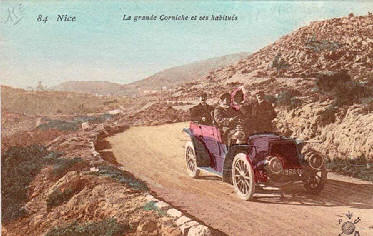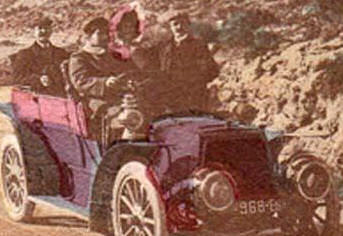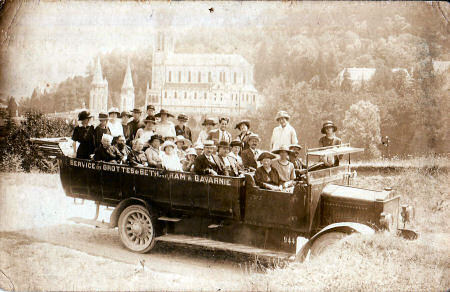










 |
 |
 |
 |
 |
 |
||
 |
 |
 |
 |
 |

the Belle Époquexavier |
||
|
|
||
new! Cathedrale Saint-Gatien at Tours
the perpendicular or English style of cathedral the fire at the cathedral of Notre-Dame de Paris Stone tracery in church and
cathedral construction stained glass and cathedrals in Normandy fortified churches, mostly in Les Landes cathedral labyrinths and mazes in France Germans in France on first arriving in France - driving Transbordeur bridges in France and the world 2: focus on Portugalete, Chicago,
Rochefort-Martrou France’s western isles: Ile de Ré Ile de France, Paris: in the context of Abelard and of French cathedrals Marianne - a French national symbol, with French definitive stamps la Belle Epoque
Pic du Midi - observing stars clearly, A64 Futuroscope the French umbrella & Aurillac 50 years old:
Citroën DS the forest as seen by Francois Mauriac, and today bastide towns |
short historical introductionLa Belle Époque, - the Beautiful Era - is an expression, born after the First World War, created to evoke the period stretching from after the Napoleonic campaigns until the watershed in Europe of the Great War: the years from 1890 to 1914. The name Belle Époque encompasses the The social disruption, turmoil and loss of the Great War, caused by the millions of young men sent away from their families and work, never to return, marked Western Europe and its societies. Women having to cope without men and replace them at work resulted in female emancipation and independence, while returning military turned against the almost feudal nature of civilian society. The Belle Epoque was coined to describe the years of peace and prosperity that marked middle-class life in France, before the Great War changed so much. The name soon spread to include many other countries in the West. The Bell Epoque had notable features, such as dress, art and, with the optimism generated by a new century, engineering feats and technological progress. Art included painting such as the Impressionists, furniture and architecture, much styled by Art Nouveau and the English Arts and Crafts movement. the Belle Epoque in EuropeAfter the Franco-Prussian War, Europe saw a long period of peace, at those times unusual yet favourable to economic and technical progress. This progress touched particularly France, the United Kingdom, Belgium, Germany, Italy and Austria-Hungary. People at that period were very optimistic and carefree about the future, thanks to the extraordinary technological advances. Positivism (Faith in science) and scientism (Science explains everything) made their appearance. La Belle Époque was manifest mainly on the streets of European capitals, in cafés and cabarets, in workshops and art galleries, concert halls and salons - places frequented by middle classes who benefited from economic progress. in FranceAfter the 19th century Great Depression of 1873/4 to 1895/6, France entered a period of sustained growth in what was termed the Second Industrial Revolution. The French population, while remaining hierarchical, became aware of belonging to a single nation. The rail network extended and helped open up the countryside, although France’s population remained largely rural. The English, from different social groups, would come to France during this period. They came both for holidays where the seaside was an attraction, especially in winter when they could escape the bleak northern winters, and because France was a cheaper and socially more accepting place to live. Exiles from the harshness of UK society included Oscar Wilde, and later the Duke and Duchess of Windsor and Oswald Mosley and his wife. Hitler chose Hendaye on the south-west coast to meet Franco, a town where later Winston Churchill would come to convalesce after World War Two. Decca Mitford lived in Bayonne when she and her reporter husband , Esmond, ran away to join the Spanish Civil War. At this period, those of very limited means and the idle classes travelled to France because of its low prices, and for fun in the sun. For the richer people, there were virtually no borders, and they discovered the newest means of touring by motor car and coach. |
|
||
  Motor touring on the coast road at Nice - "the Grand Corniche and its habitués".  Charabanc outing in the Pyrenees |
||||
The English disported themselves in casinos and on the Mediterranean coast, on the Côte d’Azur. There were so many English people staying in Nice that the main road along the sea front was named la Promenade des Anglais - the Promenade [seaside walkway] of the English. The English also came to the southern Atlantic coast, particularly to sojourn at Biarritz, with its sheltered beaches and more affluent commerce. technologyDuring this period, there were a succession of inventions that fundamentally altered people’s lives: the harnessing and use of electricity, the internal combustion engine, vaccinations against disease [invented by Louis Pasteur], the photograph, films, the bicycle. There was also immense progress made in chemistry and steel. These technological advances made life easier at all levels of society. In France, the growing command of engineering in steel were manifest in the Eiffel Tower, the Viaduct de Garabit and the Grand Palais in Paris. As well as the national demonstrations of engineering prowess, there were more local examples like the funicular train up the Rhune mountain in Pyrenees Atlantiques, built as a tourist attraction and still growing strong in the 21st century, and the moving pedestrian ramp at Biarritz, sadly dismantled to help the Great War war effort [page under preparation]. All this progress gave people a feeling of optimism, that anything was possible. |
||||
exhibitions
These major exhibitions were symbols of the Belle Epoque.
|
||||
| abstracts | briefings | information | headlines | loud music & hearing damage | children & television violence | what is memory, and intelligence? | about abelard |
© abelard, 2008,23 March the address for this document is https://www.abelard.org/france/belle_epoque.php 2025 words |